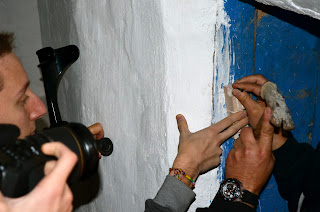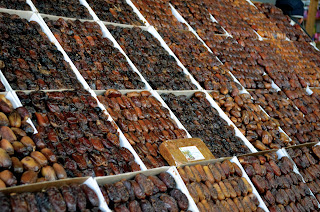Mishegas has returned from its two-month respite. Iberia will continue after Europe/Turkey. Guten tag!

Our Central Europe/Turkey trip commenced with a week in Berlin, where Germany Close Up hosted and guided us. Partially funded by the government, Germany Close Up introduces American Jews to modern Germany and contemporary German Jewish life. The programming sought to delve into the contradictions of the German experience: Germany as the origin of progressive and Reform Judaism, as well as ultimately the site of destruction of Judaism; and Berlin as the city that cultivated racism and facilitated mass-murder, as well as the same, newly-built city that promotes openness and tolerance. Fewer than a hundred years since World War II ended, memory remains something inevitably that one struggles with.

Walking through pristine modern Berlin, one inescapably endures the burden and heaviness of the past. Monuments in residential areas, such as the one to the above right, commemorate a square in which German women protested their Jewish husbands' imminent deportations and ultimately won. Gold "stumbling stones" pervade the cobblestone sidewalks of Berlin to evoke the memory of the Jews who once worked, lived, and thrived throughout the city.

One of our first stops consisted of a Jewish cemetery, built in 1672 and destroyed in World War II, that houses the grave of Moses Mendelssohn, a philosopher and forefather of the Haskalah (Jewish Enlightenment) in the eighteenth century. Constructing the foundations of Reform Judaism, he sought to integrate Jews into secular society while maintaining their faith. This ultimately backfired, as only two of Mendelssohn's six children remained Jewish. In addition, his experiment of full integration and assimilation into German culture patently failed as evidenced by the cemetery itself: this cemetery harbored German Jews before their deportation to concentration camps.

After the initial walking tour of the city, we visited the Haus der Wannsee-Konferenz, where the senior officials of the Third Reich established the Final Solution to the Jewish question. The villa, in the Berlin suburb of Wannsee, now serves as a museum and memorial. Cobblestone walking paths, white sitting benches, and trimmed bushes that act as walls line the innocuous-looking Wannsee villa. Its stone-gray front and heavy metal gates present an aura of regality and poise. Yet even in the bitter winter, the foreboding element inside house contrasts starkly alongside the beauty of its backdrop, Lake Wannsee. The weather reminded me of my days in Poland on my senior trip, where the coldness and biting wind enlivened, however morbidly, the experience.

Thereafter, we drove to Berlin-Grunewald Track 17, or Gleis 17, where the majority of deportations from October 1941 to February 1945 occurred. Most trains ventured to the Litzmannstadt and Warsaw ghettos until 1942, and afterwards directly to the Auschwitz and Theresienstadt extermination camps. The Deutsche Bahn, the national railway company, instituted this memorial in 1998.
Someone later expressed their anger and incomprehension of "living at the whim of another people."

Conversely, the following day introduced the theme of the moving forward, the future; we visited Lauder Beit Zion (another European Jewish school funded by Ronald Lauder, president of the World Jewish Congress). Headed by
Rabbi Josh Spinner (Baltimore-born and Toronto-raised), the school is part of a greater Jewish outreach organization that boasts a
yeshiva and
midrasha. Formally at 220,000, the number of speculated Jews in Germany has attained 300,000 (70 to 80 percent whom are Russian speakers).
He spoke of the growing Jewish community in Germany, his ambivalence towards his daughter rooting for German teams, and, upon request, modern anti-Semitism in Germany. Employing the
recent circumcision scandal as an example, Rabbi Spinner cited the fundamental problem in German society as one of pluralism and tolerance, rather than anti-Semitism. Rabbi Spinner expressed that the anti-circumcision support stemmed from anti-religious and xenophobic sentiment, as Germany increasingly becomes a "melting pot" country.

The Memorial to the Murdered Jews of Europe, or the Field of Stelae, remains in the heart of Berlin. Designed by Peter Eisenman, the memorial constitutes 2,711 concrete slabs in grid-like pattern and initially bears resemblance to a cemetery. Walking down through the slabs, the "tombs" mount higher and higher and produce a sense of chaos and loss of control. Supposedly, Eisenman constructed the site with no symbolism in mind; he left his design open to interpretation. In contrast to Holocaust memorials all over the world I've seen, this one proved unusually provocative and effective to me.

Finally, before Shabbos preparations, we visited the German Historical Museum. This experience provided a history of World War II from a German perspective, and, additionally, our tour guide did not know we were Jewish, which afforded another unusual perspective (after nine years of Jewish education).
For Kabbalat Shabbat, we walked to the Joachimstaler Strasse Synagogue, an Orthodox shul with many young people and much
ruach (spirit). Our dinner with them afterwards last five hours. The irony, of course, is that one of the most vivacious, effervescent shuls I've been to remains situated in the heart of the city that once promised the destruction of the Jews.
The following morning, we walked to the Pestalozzistrasse Synagogue, a "liberal" (Reform in America) shul complete with a mixed choir and an organ. However, depicting another contradiction, the congregation appeared almost entirely elderly; in the birthplace of Reform Judaism, Reform Judaism no longer thrives.

After Shabbos, we watched "The Reader" with German students and had dinner with them.
The Central Europe/Turkey experience to progress.
Gute Nacht!
Rebecca Abbott
(Kivunim -
www.kivunim.org) - a gap year before Barnard
 Kreuzberg, a district of Berlin, encompasses many minorities
and immigrants (particularly many Turks). Visiting the Kreuzberg Museum,
Kivunim met with a representative of Kreuzberg Initiative Against Anti-Semitism
who elucidated the mission to prevent and combat anti-Semitism in Berlin. She
mentioned the intimidation teachers feel in addressing the increasingly
relevant issue of the Palestinian-Israeli conflict (with a growing number of
23,000 Palestinians in Berlin).
Kreuzberg, a district of Berlin, encompasses many minorities
and immigrants (particularly many Turks). Visiting the Kreuzberg Museum,
Kivunim met with a representative of Kreuzberg Initiative Against Anti-Semitism
who elucidated the mission to prevent and combat anti-Semitism in Berlin. She
mentioned the intimidation teachers feel in addressing the increasingly
relevant issue of the Palestinian-Israeli conflict (with a growing number of
23,000 Palestinians in Berlin). After an outing to the Pergamon Museum, we concluded the day
and week with a nice dinner (beetroot and horseradish soup) and a summary
discussion at the Cutie Pie Café. The café proved as adorable with its name,
with its mini desserts and fruit and frothy drinks.
After an outing to the Pergamon Museum, we concluded the day
and week with a nice dinner (beetroot and horseradish soup) and a summary
discussion at the Cutie Pie Café. The café proved as adorable with its name,
with its mini desserts and fruit and frothy drinks.  I struggled – I fortunately do not have any family members
who endured the immediate atrocities of the Holocaust. I do not have a personal
connection – simply as personal as collective Jewish memory. However, I connected
to the Jewish historical aspect of Berlin as well as the modern city it now is.
What a strange contradiction, I thought, experiencing both aspects of the city
separately but meaningfully. How could I so fluidly detach the past from the
present? Yet I never felt repulsed or guilty for enjoying my trip – maybe this
proves a symptom of a generation too far removed from the Holocaust.
I struggled – I fortunately do not have any family members
who endured the immediate atrocities of the Holocaust. I do not have a personal
connection – simply as personal as collective Jewish memory. However, I connected
to the Jewish historical aspect of Berlin as well as the modern city it now is.
What a strange contradiction, I thought, experiencing both aspects of the city
separately but meaningfully. How could I so fluidly detach the past from the
present? Yet I never felt repulsed or guilty for enjoying my trip – maybe this
proves a symptom of a generation too far removed from the Holocaust.













































